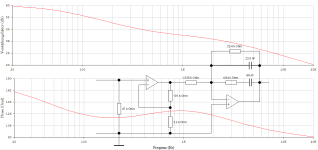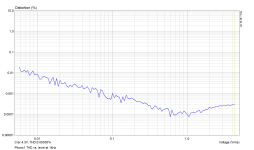In Sample A the operational amplifier should deliver about 35 to 40 mA at full swing at 20 kHz into the 23.5 nF capacitor. Less current load is better IMHO.
You will never have, under no circumstances, 15Vp at 20kHz at the phono preamp output when amplifying signals from vinyl records. And if you did, your tweeters would be dead. You may get it on the test bench from the signal generator. That is why I use the LT1010 buffer in my Openamp, though it is unnecessary. Such speculations about output current are purely academic.
Cool,In Sample A the operational amplifier should deliver about 35 to 40 mA at full swing at 20 kHz into the 23.5 nF capacitor. Less current load is better IMHO.
let's have a little bit fun.
Uout = 13Vpeak at f=20000 1/sec then Uin must be 1300Vpeak !
over the thumb:
-Iout = 13V / 324Ohm
the result is 40mA peakcurrent!
and activate both examples.In the meantime, this discussion thread has become a very profound and intellectually demanding thread.
Let's put the cart before the horse (...)
Which version is (now) the better one and why is that? Alternatively, the question could also be: what is the decisive difference in sound? The triangular symbol with the + and the - should be regarded as an ideal component, an ideal operational amplifier. The supply voltage is +/-15Vdc. We can output (swing) up to exactly 13Vp without clipping.
HBt.
Attachments
I am lost with this assumption 🙂🙂. I would say that usual MM phono preamp gain at 20kHz is about 20dB, so to get 13Vp output at 20kHz, the input would be 1.3Vp.Uout = 13Vpeak at f=20000 1/sec then Uin must be 1300Vpeak !
Theologians are still asleep, although two formidable interpretations (exegeses) of the Holy Scriptures are now finally available.
Both circuit examples have the same input stage, with completely identical data and behavior. In the following they differ as required by the two competing churches, but after the service one party is white and the other black, otherwise they have been indoctrinated in the same way.
this refers to posting #243
Both circuit examples have the same input stage, with completely identical data and behavior. In the following they differ as required by the two competing churches, but after the service one party is white and the other black, otherwise they have been indoctrinated in the same way.
this refers to posting #243
Yeah,I am lost with this assumption 🙂🙂. I would say that usual MM phono preamp gain at 20kHz is about 20dB, so to get 13Vp output at 20kHz, the input would be 1.3Vp.
so the preacher in me could confuse you for a short time and make you stagger on the path of virtue. The two examples from posting #240 do not amplify the input signal, they attenuate it.
This is exactly what low passes usually do.

HBt.
In Sample A the operational amplifier should deliver about 35 to 40 mA at full swing at 20 kHz into the 23.5 nF capacitor. Less current load is better IMHO.
Since we are a church that listens to its parishioners, because it is dependent on sheep, the desire for less burden should be fulfilled.
We are rapidly approaching a double-blind test ...
Which version sounds better to the ears of the participants being tested?
kindly,
HBt.
I like to get to the bottom of things, so I usually take a very close look at some point.OK. Frankly, I better did not check the circuits.
Obviously we both belong to the same species 🙂.IMO, it is not the best idea to attenuate the signal that is very small by nature, and then make it a subject of massive amplification. This does not make sense, to me 😉.
#
Well, the examples should finally shed some light on the darkness and put our comrades in a position where they no longer have to guess what might be hiding beneath the Earth's disk.
Example A amplifies up to f=20kHz without exception, while example B first amplifies (+30dB) and then attenuates the signal depending on the frequency (-20dB at 1kHz and -40dB at 20kHz, all of course only asymptotically) and then amplifies it again with +30dB.
Well,
that must inevitably sound different now - but which exegesis is the better one, i.e. the only true one?
And if they are considered equal in the testers' test field, the question of clicks and pops still remains unanswered. After all, we expect white or black to be different in some way.
HBt.
😱
I still do not understand what are some of the contributors afraid of. Below are the shots from the simplest, 1-opamp phono preamp with feedback RIAA EQ. Input signals from the generator are absolutely unrealistic - big 20kHz sine and 1kHz 2% duty cycle square (short impulses with fast edges). There is no clipping, no dv/dt saturation, just the response of RIAA EQ circuit.
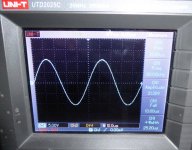
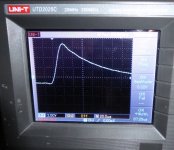
I have quickly built this simple phono pre this afternoon, just for the benefit of our dear readers.
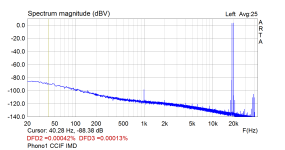
P.S.: supply voltage is +/-13.5V, just what I had here.


I have quickly built this simple phono pre this afternoon, just for the benefit of our dear readers.

P.S.: supply voltage is +/-13.5V, just what I had here.
Last edited:
Well, I also carried out extensive series of measurements on two test subjects (Supra24 & Ruby3 and the Pass Pearl 1) last week. I wrote: there are no problems! When we were still stuck at the point of the huge impulses and the behavior after non-given clippings.
After that, the battlefield shifted and a lot of emphasis was placed on rhetorical games, namely the listener's individual evaluation filters, with the narrative:
You can't know anything about what Paul has heard and Ida always hears something different from Martin anyway.
It has to be said that all three listened to the live performance of Peter and the Wolf.
Only they didn't know it, because all three of them don't have the ability of visual perception, they are blind. All three were led around by the nose in this hearing test.
Since this realization, they have trusted the experts and their certified specialist knowledge, especially in the field of measurement technology.
#
Let's all just agree on the wisdom: beauty is in the eye of the beholder.
However, as soon as we want to objectively compare beauty A with beauty B, we cannot avoid taking measurements and we have to set standards.
HBt.
After that, the battlefield shifted and a lot of emphasis was placed on rhetorical games, namely the listener's individual evaluation filters, with the narrative:
You can't know anything about what Paul has heard and Ida always hears something different from Martin anyway.
It has to be said that all three listened to the live performance of Peter and the Wolf.
Only they didn't know it, because all three of them don't have the ability of visual perception, they are blind. All three were led around by the nose in this hearing test.
Since this realization, they have trusted the experts and their certified specialist knowledge, especially in the field of measurement technology.
#
Let's all just agree on the wisdom: beauty is in the eye of the beholder.
However, as soon as we want to objectively compare beauty A with beauty B, we cannot avoid taking measurements and we have to set standards.
HBt.
Wow,I have quickly built this simple phono pre this afternoon, just for the benefit of our dear readers.
you're also a
"son of a gun"
Ein echter Teufelskerl like @EdGr
👍
🙂
greetings,
HBt.
Hierfi, presumably YOU have "heard differences" between passive EQ RIAA preamps and EVIL non-inverting feedback ones.This presupposes that you get to ask questions of those stating "I heard differences". A failure to respond does not refute the reality.
Can you tell us what were these DUTs and also the circumstances where you, "heard differences" ?
If this is only something you heard from someone else, that's OK too. But we need to know so we can put these propositions in their proper place
In arguments specific to the postulate that active RIAA networks are superior to passive RIAA networks is inherent flawed for reasons passive current RIAA's are not recognized. Using values for an active RIAA as per below left these values can be replicated for passive voltage and passive current RIAA networks in LTSpice, this without simulating active elements.
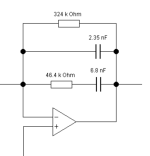

The voltage and current RIAA derivatives in LTSpice are simply an AC translation in the movement of R2 to R3 or visa versa. The legitimacy of this AC translation is evidenced by the near identical overlap in the simulation results (the voltage to current translator being set slightly off to cause this to show up).
As considered self evident the active RIAA network depicted is current feedback RIAA network, hence of identical form in the connection of its elements to the passive current RIAA network, not the passive voltage RIAA. Hence to argue that active RIAA is superior to passive RIAA ought better to be conducted in equity of comparison whereupon both are operating in the current mode, one active and one passive. Currently there appears a fundamental misunderstanding of the nature of the comparison.


The voltage and current RIAA derivatives in LTSpice are simply an AC translation in the movement of R2 to R3 or visa versa. The legitimacy of this AC translation is evidenced by the near identical overlap in the simulation results (the voltage to current translator being set slightly off to cause this to show up).
As considered self evident the active RIAA network depicted is current feedback RIAA network, hence of identical form in the connection of its elements to the passive current RIAA network, not the passive voltage RIAA. Hence to argue that active RIAA is superior to passive RIAA ought better to be conducted in equity of comparison whereupon both are operating in the current mode, one active and one passive. Currently there appears a fundamental misunderstanding of the nature of the comparison.
As considered self evident the active RIAA network depicted is current feedback RIAA network
Great, current feedback has four contradictory meanings now. I thought three was bad enough.
Hopefully clearer, current feeding the inverting terminal from some source is fed back through the RIAA network to set a virtual ground at the inverting terminal. The distinction between active RIAA and passive current RIAA is that the active has a virtual ground and the passive a real ground. This is what the comparison becomes.
To advance this further how is an active RIAA in comparison to passive voltage RIAA of significance variant from a comparison of passive current RIAA to passive voltage RIAA. Its passive voltage that's the problem, not because the RIAA happens to be active.
To advance this further how is an active RIAA in comparison to passive voltage RIAA of significance variant from a comparison of passive current RIAA to passive voltage RIAA. Its passive voltage that's the problem, not because the RIAA happens to be active.
Last edited:
The polarity changes as well. Polarity changes can be audible under double-blind conditions, although they easily get masked by reverberation.
- Home
- Source & Line
- Analogue Source
- RIAA Overload Performance’ to Encoded Signals (i.e. the Music) and Response to Clicks and Pops (Unencoded)
